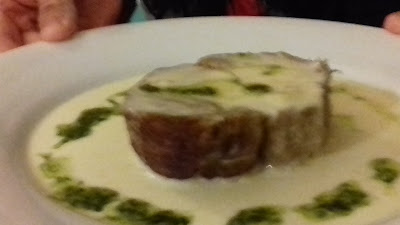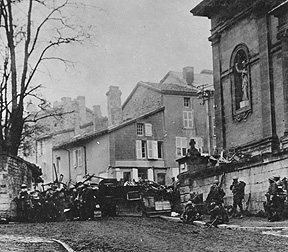I had cervelle d'agneau meunière at the Tête de Lard bouchon one Friday night with some of my classmates from the Inflexyon language school. We wanted an authentic Lyonnais experience and figured the bouchon was probably the best way to get it.
A bouchon is a traditional restaurant of Lyon. It uses animal organs from cows, ducks, pigs, and sheep to make such dishes as andouillette (sausage of intestines and/or blood), foie de veau (veal liver), tête de veau (veal head), échine de cocher (pork spine), onglet de boeuf (beef tab on the stomach), and cervelle d'agneau (sheep brains).
My classmates and I felt that this sounded like pretty gruesome fare, but eating all parts of the animal instead of just the muscle is a testament to the French aversion to wastefulness as well as a celebration of tasty, rustic peasant food. The dishes are typically fatty given the types of meats used, and they are nowhere near the lighter and fancier haute cuisine we usually associate with French food.
Bouchons originated in the 18th century through "the Lyon mothers." As the website, Les Bouchons Lyonnais states:
[The mothers] were cooks from humble origins. They set up their own businesses after working for bourgeois families in Lyon. The Mothers cooked simple and refined food. They used inferior cuts as they were in the habit of not throwing anything away.
The Lyon mothers flourished during the inter-war period. The impact of the war and the 1929 economic crisis were to change the face of Lyon’s cuisine. A lot of these cooks were dismissed from the homes where they worked. This is when they opened their own restaurants… much to our delight! Workers, celebrities and rich businessmen sat side by side at their tables, in a friendly atmosphere!
Among the most famous mothers were Mère Françoise Fillioux (1865-1925) and More Eugénie Brazier (1895-1977), dubbed the "Mother of Modern French Cooking." She was the first woman to win three Michelin stars and among her famous protegés is Paul Bocuse. Mère Fillioux also earned three Michelin stars. For more information about the mothers, check out Lyonresto.com.
The Bouchons are anxious to guarantee both the quality of products and cuisine as well as the authenticity of their tradition, which includes the bouchon's welcome, ambience, and respect for Lyon's history and heritage. In 1997, Pierre Grison created the organization, L'Association de Défense des Bouchons Lyonnais (Association for the Preservation of Lyonnais Bouchons), which certifies bouchons as "authentic." There are about 20 officially certified bouchons in Lyon and the Tete de Lard is among them.
Typical items in the bouchon repertoire include:
- Soup
- Tripe soup, pumpkin soup
- Salads and cold appetizers
- Chicken liver salad, pork head cheese, groins d'âne salad (literally, "donkey snout" salad), marinated herrings, salade Lyonnaise (lettuce with bacon, croutons, mustarddressing, and a poached egg)
- Hot appetizers
- gateau de volaille (chicken liver cake), boudin noir (blood sausage, usually served with warm apples)
- Offal
- Andouillette (pork offal sausage), assorted offal gratin, tablier de sapeur
- Fish
- Stingray, quenelles (ground fish dumplings), grilled fillets
- Meat
- Coq au vin, pot au feu (pot roast), chicken thighs stuffed with morels
- Vegetables
- Cardoon à la moelle (in bone marrow), barboton, pailasson de Lyon
- Cheese
- Saint-Marcellin, Saint-Félicien, Rigotte de Condrieu
- Desserts
- tarte praline (praline tart), lemon meringue pie, caramelized apples, bugnes de Lyon(miniature beignets)
 |
| One of the great perks of the Inflexyon school is that it provides students with the opportunity to meet other students from all over the world. My new friends here represented the countries of Brazil, China, Hong Kong, Iraq, Japan, and Thailand. I was one of the few Americans at the school, however, nearly everyone I met spoke English, which is routinely accepted as a universal language. However, during our dinner at the bouchon, we all spoke French. Our instructors would be proud of us! |
At first, it was a little difficult to choose from the menu options because the dishes were so unfamiliar. In fact, we took out our cell phones to look up words that described the dishes. Once I found cervelle, however, I knew I had to have it. My Dad ate brains when he served in France during World War II, so I wanted to try them. He said they looked like cauliflower but were more tasty. My cervelle was light with a crusty finish to its soft but not mealy interior. The lemon, butter and parsley meunière sauce made it tangy.
Meunière refers to both sauce and a method of preparation. Cooking something à la meunière requires that the meat is first dredged in seasoned flour and then sautéd in brown butter, chopped parsley, and lemon. Meunière means "miller's wife" in French, which refers to its non-elaborate rustic nature.
Since my friends and I had almost everything on the menu, we could see and taste each other's dishes. We generally found the food good and tasty and its appearance not at all what we imagined. But as one other student who had eaten at a bouchon a couple weeks before said, "In order to try the food, you have to get over the fact of what it is." As is evident in the following photos, the chef knew how to present the food to make it both appetizing and appealing.
The bouchon once again demonstrates my contention that every food they make in France is great.

The menu board at La Tête de Lard was simple and affordable. Each plat (main dish) included a complementary appetizer of crispy pork rinds and saucisson (pork sausage). Hmmm, good!


We also received a casserole dish of au gratin potatoes to share among us.
Below are photos of my friends' dishes.
 |
Lyonnaise salad with a soft-boiled egg to drape thick pieces of bacon and fresh lettuce.
Foie de veau persille
(calf's liver with parsley sauce)
Onglet de boeuf sauce St. Marcellin (tab of beef with a sauce made from St. Marcellin cheese mixed with cream, stock, mushrooms)
Tête de veau (veal head) in gribiche sauce (mayonnaise-style cold hard-boiled egg yolks, mustard, and oil finished with chopped pickled cucumbers, capers, parsley, chervil and tarragon)
Échine de cocher à la crème de lard (pork spine with a sauce of cream and bacon)





























